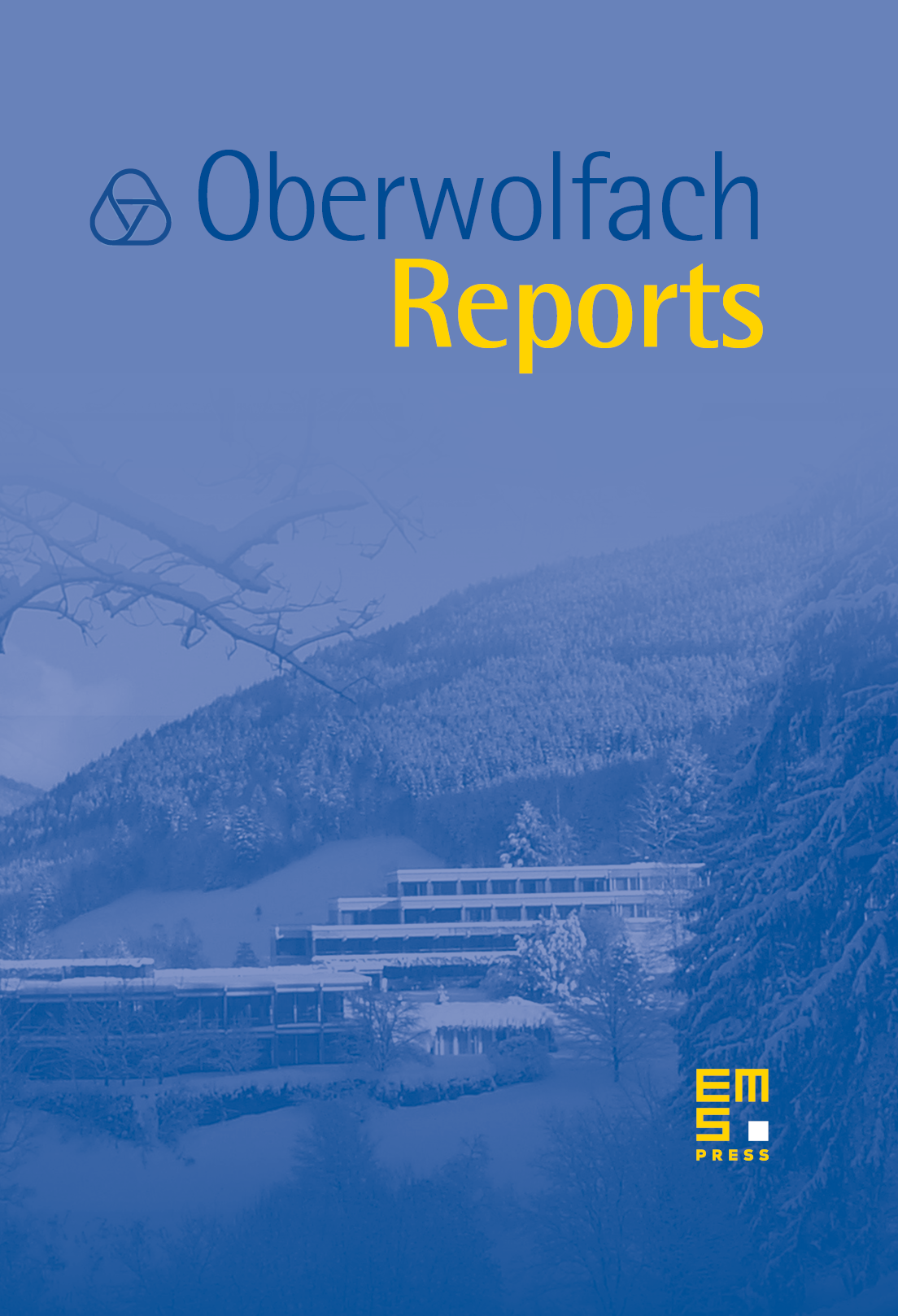Geometric Topology and Connections with Quantum Field Theory
Peter Teichner
University of California, Berkeley, USAStephan Stolz
University of Notre Dame, USA

Abstract
The workshop Geometric Topology and Connections with Quantum Field Theory, organised by Stephan Stolz (Notre Dame) and Peter Teichner (La Jolla) was held June 12th–June 18th, 2005. As mentioned above, this workshop was intendend to bring together people working in the fields of traditional geometric topology and theoretical physics. For that purpose, the organizers asked several well known expositors like Dror Bar-Natan, Dan Freed and Graeme Segal to give survey lectures in some of the most exciting connections between topology and QFT. In what follows we give a brief survey of the three most central topics.
Elliptic Cohomology: The elliptic cohomology of a space is the home of the ‘Witten genus’ of a family of ‘string’ manifolds parametrized by , similarly to the role of the K-theory of as the home of the family version of the A-roof genus of a family of spin manifolds parametrized by (i.e., a fiber bundle over with spin manifold fibers). There is now a homotopy theoretic construction of elliptic cohomology (the ‘topological modular form theory’ TMF of Hopkins and Miller) and one of the highlights of the workshop was Jacob Lurie's lecture about his new interpretation (and construction) of TMF via ‘derived algebraic geometry’. This approach makes many aspects of TMF more transparent and allows for things like an equivariant version to be defined.
There is also a family version of the Witten genus with values in TMF due to Ando, Hopkins, Reszk and Strickland, however, a geometric/analytic construction of elliptic cohomology and the Witten genus (say analogous to the description of as families of Fredholm operators parametrized by ) is still missing. This is despite a two decade old proposal of Graeme Segal to interpret elements of the elliptic cohomology of essentially as families of conformal field theories parametrized by . Segal gave the opening lecture in the workshop, surveying some of the progress along the lines of his proposal. During the last two years various more precise candidates for a geometric definition of elliptic cohomology were developed. These were represented by the talks of Rognes and Hu-Kriz and an informal evening session by Stolz–Teichner. Antony Wasserman presented an approach to construct outer representations of Lie groups which may well be the starting point of an equivariant version of one of these geometric theories.
Differential K-Theory: The differential K-Theory of a manifold is a crossover between differential forms and K-theory. For example, Freed and Hopkins have recently announced a version of the AtiyahSinger Index Theorem which is expressed as an equality of an ‘analytical’ and a ‘topological’ index, both of which live in a ‘differential K-theory group’. This version of the Index Theorem represents a common generalization of the K-theory version of the Index Theorem and the Local Index Theorem. This way, differential K-theory groups can be seen as the common place where geometric aspects of the manifold, encoded as index densities of associated geometric operators meet topological aspects encoded in the K-theory class represented by the principal symbol of these operators. Moreover, what physicists call ‘abelian Gauge fields' also fits naturally into this context, where, depending on the phycisal setting, K-theory may have to be replaced by another generalized cohomology theory. Talks by Ulrich Bunke, Dan Freed, Mike Hopkins and Greg Moore represented this aspect of the workshop.
Closely related is the geometry of ‘gerbes’; isomorphism classes of gerbes over a space are classified by elements of (like complex line bundle are classified by . As connections on complex line bundles show up in physics (as ‘electromagnetic potential’) so do geometric structures on gerbes (‘B-fields’) which in particular give 3-forms representing the deRham cohomology class of the gerbe. There are also nonabelian version of such gerbes, explained in lectures of Aschieri-Jurco and related to Andre Henriques' talk.
Topological quantum field theory: Recently, there has been much advance in this area of low-dimensional topology. Khovanov homology is a categorification of the Jones polynomial of knots in 3-space and it was used to distinguish the smooth and topological 4-genus of certain Alexander polynomial one knots. This is the first combinatorial, non Gauge theoretic, argument that smooth and topological -manifold are very distinct. Dror Bar-Natan gave a survey of this theory and then Sergej Gukov explained an approach that could possibly lead to a categorification of the two variable Homfly-polynomial.
Another very exciting conjecture in this area is the volume conjecture, relating a certain asymptotic behavior of the Jones polynomial at special values to the hyperbolic volume of a knot. Stavros Garoufalidis gave the closing lecture of the workshop on some progress that he and Thang Le made in this area.
The format of the workshop was 4 lectures per day, except for Wednesday afternoon when we arranged a hike as well as a soccer game. We were very happy with the large amount of interaction that was going on inside and across the various groups of researchers. In addition, the relatively large number of young participants contributed a lot of activity through their curiosity and insistence. Finally, we are particularly thankful to the physicists Aschieri, Jurco, Gukov and Moore, as well as to the semi-physicists Freed and Segal for their participation. They were certainly among the most looked after discussion partners.
Cite this article
Peter Teichner, Stephan Stolz, Geometric Topology and Connections with Quantum Field Theory. Oberwolfach Rep. 2 (2005), no. 2, pp. 1505–1546
DOI 10.4171/OWR/2005/27